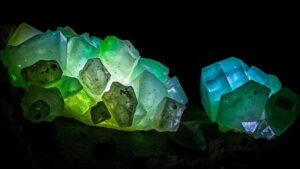Meteorite Secrets Beneath the Sand: Hunting for Space Rocks in Hidden Craters
Meteorite Secrets Beneath the Sand: Hunting for Space Rocks in Hidden Craters
The quest for meteorites–be they small flecks or massive remnants–offers rockhounds and mineral collectors the thrill of uncovering pieces of the universe. Meteorites, remnants of asteroids or comets that survive their fiery descent through Earths atmosphere, are not just scientific treasures; they also provide fascinating insights into the formation of our solar system. This article explores strategies for finding these hidden gems, emphasizing the value of locations such as ancient craters often obscured by sand and time.
Understanding Meteorites
Meteorites are categorized into three main types: stony meteorites, iron meteorites, and stony-iron meteorites. Each type has unique characteristics that can help collectors identify them:
- Stony Meteorites: Comprising about 94% of all meteorite finds, these are often further divided into chondrites (which contain small spherical inclusions called chondrules) and achondrites (which lack chondrules).
- Iron Meteorites: These are primarily composed of metal, typically iron and nickel, and are known for their density and unique Widmanstätten patterns, which can be seen when cut and polished.
- Stony-Iron Meteorites: These rare specimens contain roughly equal parts of metal and silicate materials, providing a fascinating glimpse into the formation of both asteroids and planets.
According to the Meteoritical Society, over 60,000 meteorites have been classified thus far, with only around 1,200 recognized finds each year. The rarity of these rocks adds significantly to their allure for collectors.
Finding Meteorites in Hidden Craters
While meteorites can land anywhere, certain environments increase the likelihood of finding them. One of the most effective strategies involves exploring ancient impact craters. e locations, often eroded and covered by sand, can be hotspots for meteorite recovery. Here are some elements to consider:
- Research Crater Locations: Historical craters, such as the Barringer Meteor Crater in Arizona, have yielded numerous finds. Studying geological maps and accessing databases like The Planetary Data System can help identify potential sites.
- Sand Dynamics: Wind and water erosion often expose meteorites buried beneath sand, making these areas prime for hunting after storms or heavy rains.
- Geological Surveys: Utilizing local geological surveys can provide insights into sediment layers, pinpointing where meteorites may lie hidden.
The Tools of the Trade
Equipping yourself with the right tools can greatly enhance the chances of successful meteorite hunting:
- Metal Detectors: Many meteorites contain iron, making metal detectors valuable for locating them.
- Field Guides: Having a reputable guidebook on meteorites can assist in accurate identification.
- Geological Hammer: Useful for breaking off crusty layers to reveal potential meteorites underneath.
Practical Tips for Collectors
For rockhounds venturing into meteorite hunting, consider the following practical tips:
- Join Local Clubs: Engaging with clubs or groups focused on meteorite hunting can provide mentorship, resources, and access to exclusive hunts.
- Document Finds: Always document the location and condition of each meteorite collected. This information can be crucial for validating the find and assessing its scientific value.
- Participate in Citizen Science: Many organizations seek amateur contributions. By reporting finds to places like NASA or The Meteoritical Society, collectors can help advance scientific understanding.
The Science Behind Meteorite Composition
Understanding the composition of meteorites not only enhances a collectors appreciation but also informs hunting strategies. For example, stony meteorites can have a range of ages. Many of these rocks date back approximately 4.5 billion years, making them older than Earth itself. Their study can contribute to our understanding of the solar systems early formative processes.
In particular, isotopic studies have shown that certain meteorites, such as carbonaceous chondrites, contain organic compounds that may offer clues about the origins of life on Earth. By analyzing isotopes, scientists have debated the potential for life-sustaining conditions within asteroids.
Conclusion
The search for meteorites is not just a hunt for exotic rocks but an exploration of the cosmos. By focusing on hidden craters and utilizing the right tools and strategies, collectors can uncover pieces of the universe that tell stories billions of years in the making. Meteorite hunting fosters a deeper connection to the Earth’s history and the greater solar system while supporting scientific inquiry and appreciation.
As you embark on your meteorite hunting adventures, remember to respect the local environments and follow any applicable laws or guidelines to ensure ethical collecting. Ultimately, every new find is not just a rock; its a story from the stars.



